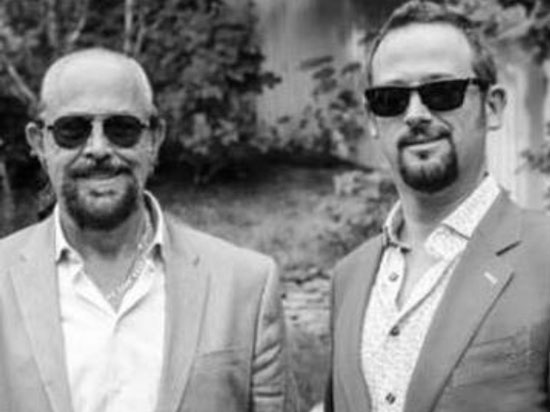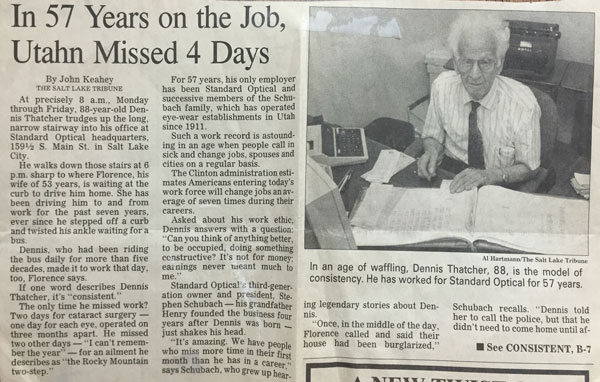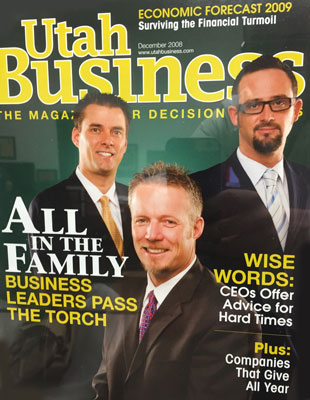
Stephen (l) and Aaron Schubach represent the third and fourth generation
of the family that founded Standard Optical in 1911.
SALT LAKE CITY, Utah—Standard Optical is one of those rare companies that not only has passed the 100-year milestone but also remains in the hands of family members. Founded here in 1911 by Henry Schubach, Standard Optical is currently under the management of third and fourth generation family members, Stephen and Aaron Schubach, respectively. It has grown from a single location over a century ago to 19 locations in operation throughout Utah today, with more expansion planned for the future, the Schubachs told dba.
After arriving by train in Salt Lake City as merchants of costume jewelry, company founder, Henry, and his brother William, sold out their entire inventory and decided this was a good place to set up shop. While William remained in the jewelry business, Henry opened Schubach Optical. Unfazed by the fact that the business didn’t do well under that name, he decided to open up down the street with a new name, Standard Optical, in 1911, and the rest is, as they say, history . . . over 100 years of it.
Henry’s sons Robert and Richard Schubach took over the business just after World War II, with Robert selling his shares to Richard in the 1980s. Today, the company is run by CEO/president Stephen (who bought out his brothers) and COO/VP Aaron, who was brought on in 1999 after finishing his education at Utah State University.

Old newspaper ads show Standard Optical’s $1 per week in-house payment plan
that enabled the company’s founder to fund radio advertising.
Among Aaron’s tasks when he joined the company were modernizing the company’s logo, which hadn’t changed since it was founded 88 years prior, investing in lasik, and resurrecting the company’s vision insurance company, Opticare, which had been founded in the mid ‘80s but was dormant at the time. Today, with Aaron as CEO, Opticare covers 300,000 lives with a panel of 13,000 doctors and is licensed not only in Utah but also in Missouri, Illinois and Arizona.
Investing in Employees
While it’s often said that a company’s success is in the hands of its staff, Standard Optical epitomizes that axiom, proven by the fact that some employees have been with the company for decades. “Our employees are as important as our customers,” Aaron said, during an exclusive interview with dba, recounting the history and discussing the future growth of Standard Optical.
Stephen said, “I’ve never been the longest employee or the highest paid employee.” Both he and Aaron cited examples of individuals employed by the company for decades, including an individual who worked there for 57 years. “People tend to stick around,” Stephen said, explaining that “50 percent of our time is devoted to employees. We know their names and their families and would do anything to help them.”

A credit to Standard Optical’s commitment to its employees,
Dennis Thatcher missed only four days in 57 years on the job.
Among the ways employees are treated like family, Stephen explained, is through an IOU program that provides interest-free loans to get out of a jam. “If we want to get along, we have to like who we work with,” he said.
Education is another way the company invests in its employees. For example, even though licensure is not required for opticians in the state of Utah, Standard provides its opticians with the education necessary to achieve ABO certification. “We take people, our opticians, who start out not knowing a lot, and train them into a career,” Aaron said.
In addition, Standard Optical also invests in leadership training, where “feedback from colleagues” provides a “three-day extensive look in the mirror to learn weaknesses,” Aaron said. “It’s valuable for them as human beings and it makes us more competitive,” in a region where he explained that “Walmart is the biggest competitor.”
 Aaron Schubach appeared on the cover of
Aaron Schubach appeared on the cover of
Utah Business magazine.Highly Incentivized Salaries
The company’s ability to compete and its ultimate success are also encouraged through a highly incentivized compensation structure. The majority of managers’ salaries, 70 percent, are based on incentives, and doctors are paid on a 50/50 salary/incentive basis. “There’s no ceiling on their earnings,” Stephen said, describing the incentive program as “complicated” and based on a formula that includes numbers from sales of premium products, lenses, lasik, multiple pairs, contact lens annual supplies, contact lens compliance, and more. To illustrate the effectiveness of the program, Stephen cited the fact that the company averages 68 percent in annual supplies of contact lenses sold.
Managing a complex incentive program requires the ability to track sales and other parameters on a daily basis. For this, Standard Optical relies on the Acuity Logic practice management system from Eyefinity. “We’re both athletic,” said Aaron, “so we need a trend report, a scoreboard, to know when we hit goals.”
New and Traditional Media
Standard Optical doesn’t rely solely on its employees to generate sales but also brings in new patients through marketing, using both traditional techniques and new media such as mobile and the internet. While the company pays attention to search engine optimization and search engine marketing and uses Solutionreach to broadcast via email and mobile, it also spends about $1 million annually on 44 weeks of television advertising. “We advertise for traffic and merchandise for profit,” Aaron said. While the television ads promote two pairs for $69, Standard Optical’s average eyeglasses sale price is just over $300.
Another way the company set out to “be in control of our destiny,” Stephen said, was to be among the multi-office eyecare providers who founded Opti-Port in 2001. The national alliance of regional optical groups provides not only group buying discounts but educational and networking opportunities as well.
As a member of Opti-Port, Standard Optical can outsource its lab work to the centralized lab, First Look Lab, operated in St. Louis by this national alliance of multiple-location regional optical groups. Aaron described the First Look Lab as a partner lab that handles all its digital lens production. All of its digital equipment is from Schneider, and it just installed its second in-house anti-reflective coating machine from Satisloh.
Medical Model
Among its 19 locations, Standard Optical operates a surgery center where it employs ophthalmologists who perform lasik, cataract and corneal transplant surgery. Aaron describes this as a “major area of the business” following a “hub-and-spoke” model where patients are referred from the other locations. “We’re investing in new equipment, mostly on the surgery side,” he said. Since adding lasik in 1999, Standard Optical has performed over 20,000 operations.
Expansion Plans
While Standard Optical is growing its medical component, it is also in growth mode either through acquisition or with organic startups of new locations. “Our market can stand six to seven new locations,” Stephen said.
After opening its 19th store this year, in South Jordan, Utah, both Stephen and Aaron told dba they have plans to expand further. While all locations are currently in the state of Utah, Aaron suggested that some “surrounding markets are very interesting,” citing Idaho, Oregon, Washington and Colorado. Focusing in even closer, they mentioned Boise, Idaho, specifically as an enticing market for expansion. They told dba that they have a goal of 60 locations in three years.